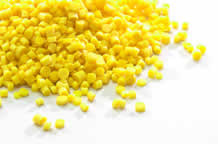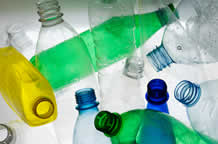
PET, which stands for polyethylene terephthalate, is a clear, strong and lightweight plastic belonging to the polyester family.
It is typically called “polyester” when used for fibers or fabrics, and “PET” or “PET Resin” when used for bottles, jars, containers and packaging applications.
PET is the world’s packaging choice for many foods and beverages because it is hygienic, strong, lightweight, shatterproof, and retains freshness. It is most commonly used to package carbonated soft drinks and water. Consumers can identify PET containers by the triangular #1 resin identification code found on the bottom of PET bottles and jars.
Think of PET as #1

Virtually all single-serving and 2-liter bottles of sodas and water sold in the U.S. are made from PET plastic. PET is also popular for packaging salad dressings, cooking oil, peanut butter, shampoo, liquid hand soap, mouthwash, and other personal care items. Special grades of PET are used for take-out containers and prepared food trays that can be warmed in the oven or microwave.
PET is a very inert material that is resistant to attack by micro-organisms, and does not react with food products, which is why it is widely preferred for packaging foods, beverages and pharmaceuticals. Health-safety agencies around the world have approved PET as safe for use with foods and beverages.
Best of all, PET is recyclable and highly sustainable. It is the most recycled plastic in the United States and worldwide. PET can be recycled again and again – back into containers for foods, beverages and personal care products – or into carpet, clothing, automotive parts, construction materials, industrial strapping, and scores of other products.
Although the feedstocks for PET are petroleum based, the environmental impact of PET is very favorable in comparison to glass, aluminum and other recyclable container materials. That’s because the light weight and strength of PET allows more product to be delivered with less packaging weight and less fuel than most other container materials.
How PET is Made

The basic building blocks of PET are ethylene glycol and terephthalic acid, which are combined to form pellets of PET. These resin pellets are then heated to a molten liquid that can be easily extruded or molded into items of practically any shape.
More specifically, when the two raw materials of PET are combined under high temperatures and low vacuum pressure, long chains of the polymer are formed. As the mixture becomes thicker, the chains grow longer. Once the appropriate chain length is achieved, the reaction is stopped. The resulting spaghetti-like strands of PET are then extruded, quickly cooled, and cut into small pellets.
When the resin pellets are reheated to a molten liquid stage, the polymer chains can be stretched in one direction (for fibers) or in two directions (for bottles and films). If the polymer is cooled quickly while it is stretched, the chains are frozen with their orientation intact. Once set in stretched form, the material is extremely tough.
If PET is held in the stretched form at elevated temperatures, it slowly crystallizes and starts to become opaque, more rigid and less flexible. This crystalline form PET is often used for take-home and prepared-food containers and trays that can be reheated in the oven or microwave.
History

PET was first synthesized in the U.S. during the mid-1940s by DuPont chemists, who were searching for polymers that could be used to make new textile fibers. DuPont would later brand these polyester fibers as “Dacron.”
In the late 1950s, researchers found a way to stretch a thin extruded sheet of PET to create PET film, which today is used extensively as video, photographic and X-ray film, as well as for packaging films.
In the early 1970s, the technology was developed to allow for the blow-stretch molding of PET into strong, lightweight and shatterproof bottles. In 1973, the PET bottle was patented and quickly gained market acceptance. In 1977, the first PET bottle was recycled.
Today PET is one of the world’s most commonly used, versatile and trusted materials. More than half of the world’s synthetic fiber is made from PET, and almost all individual-sized and 2-liter bottles of carbonated soft drinks and water sold in the U.S. are made from PET resin.
